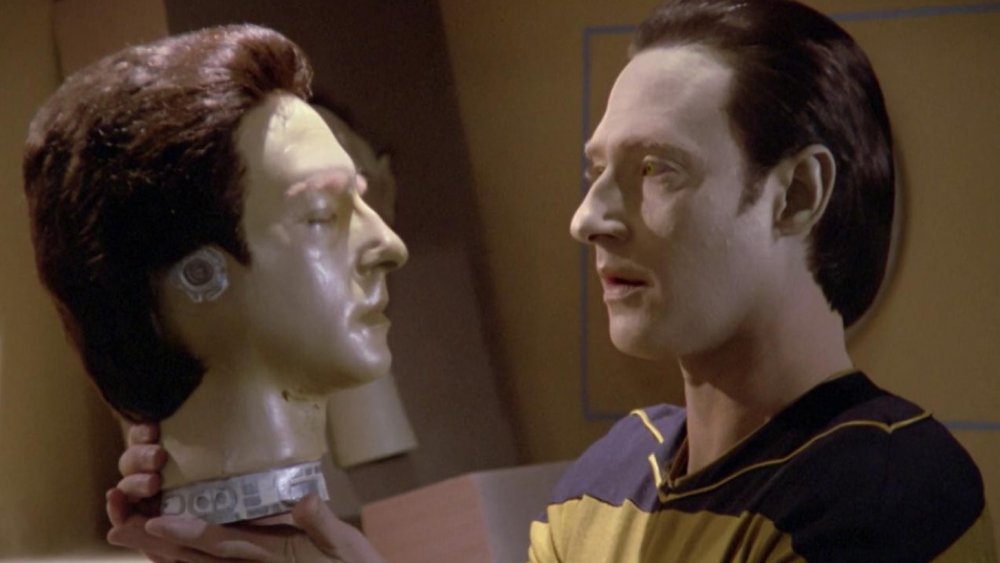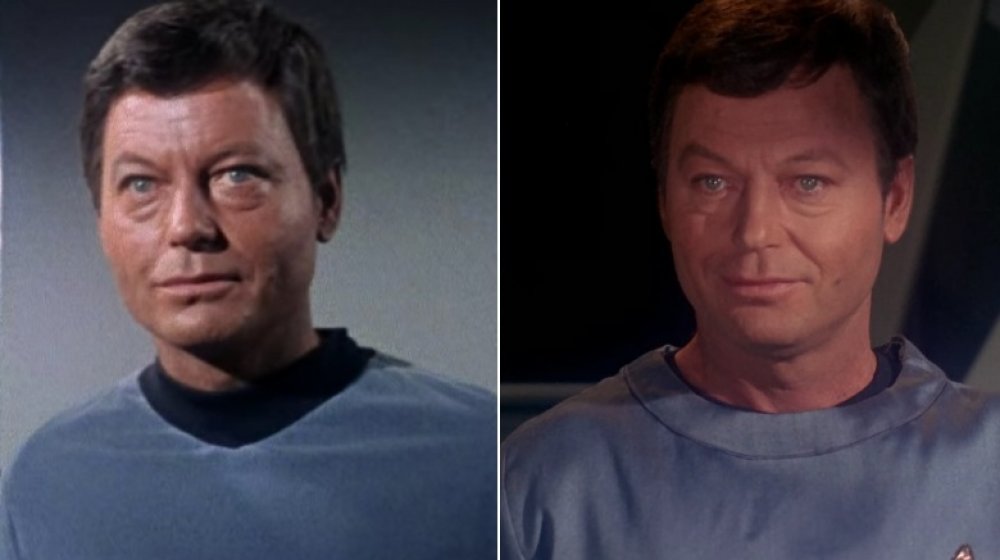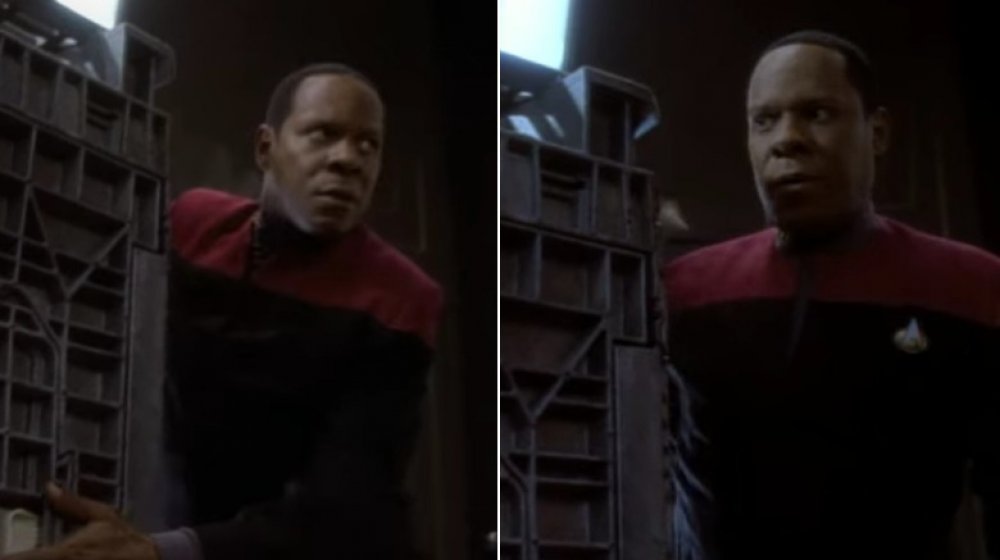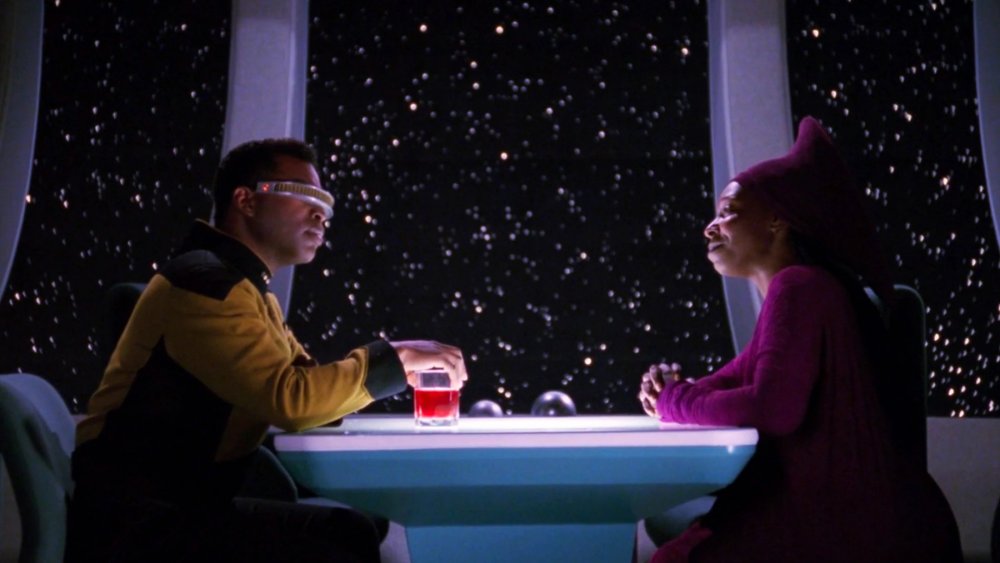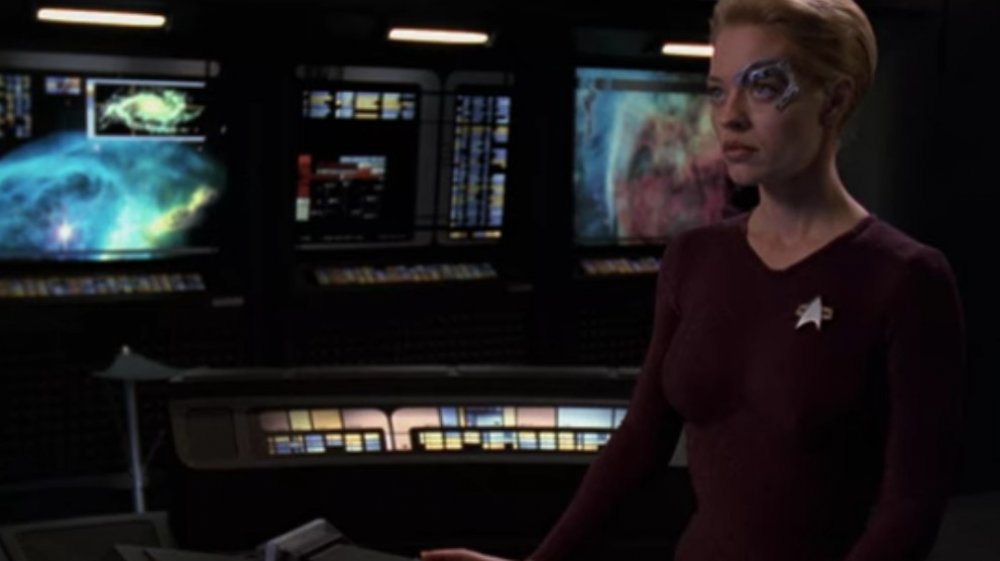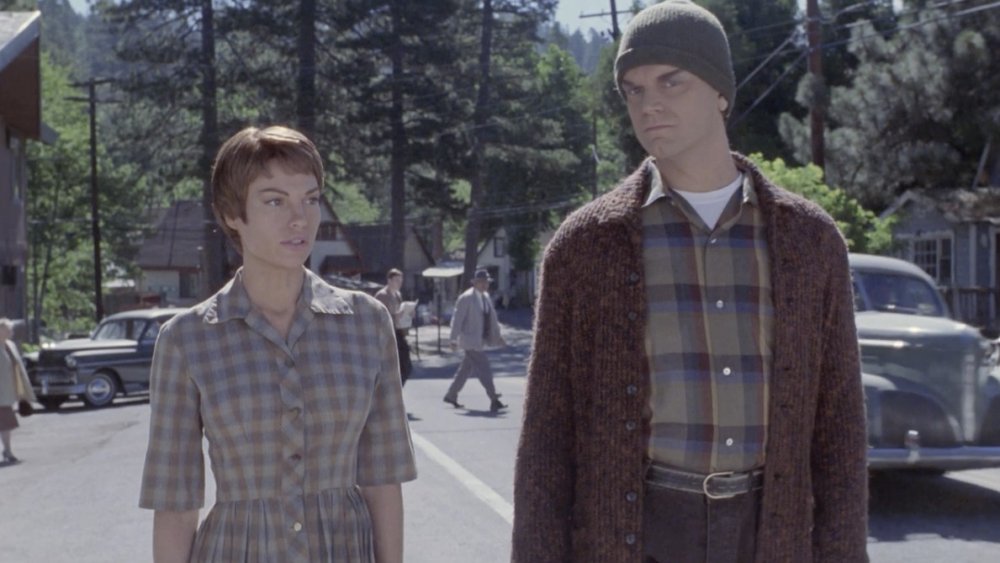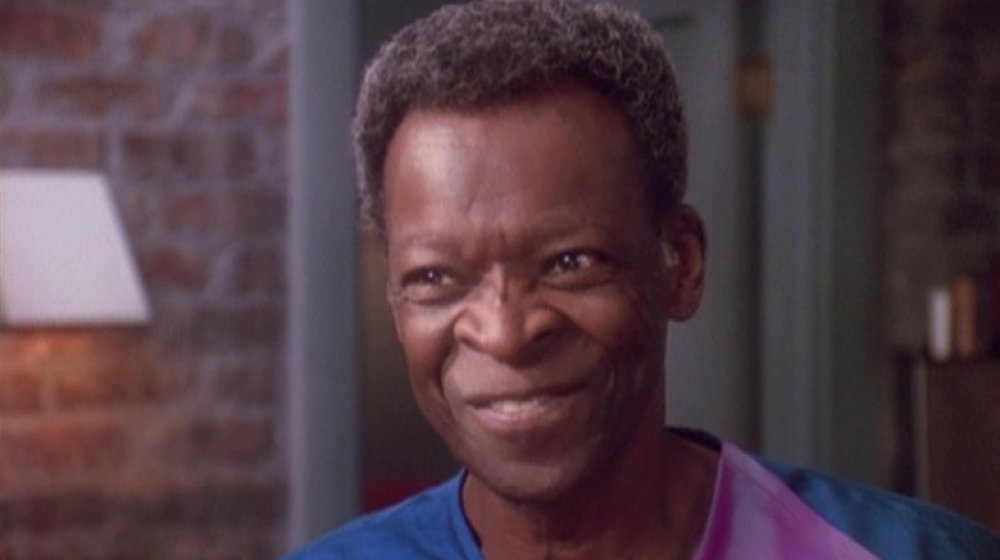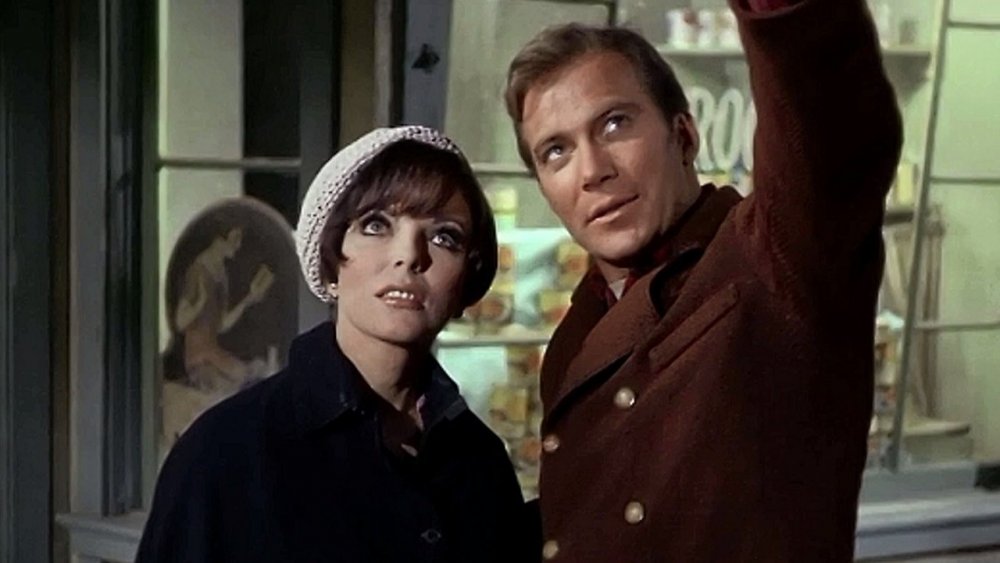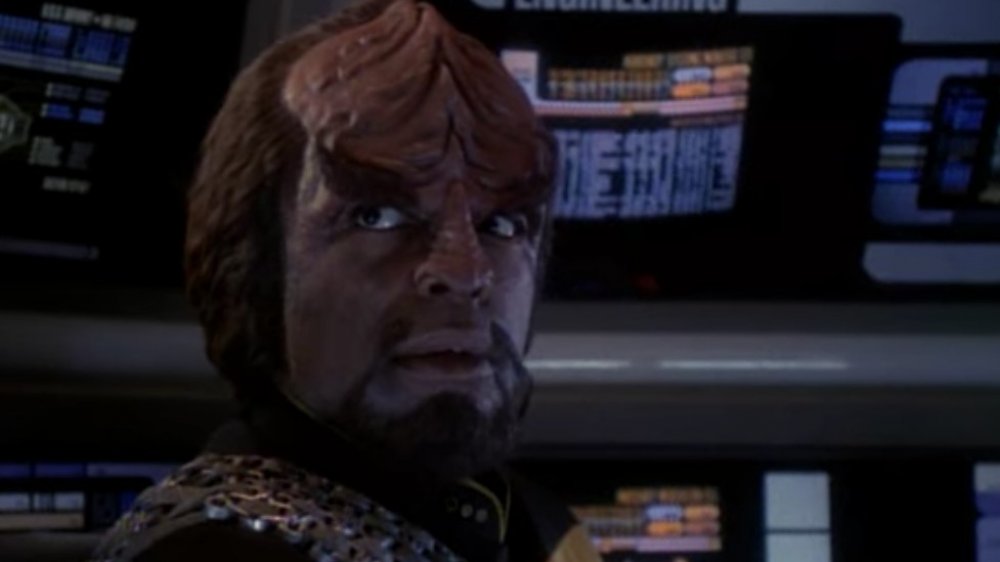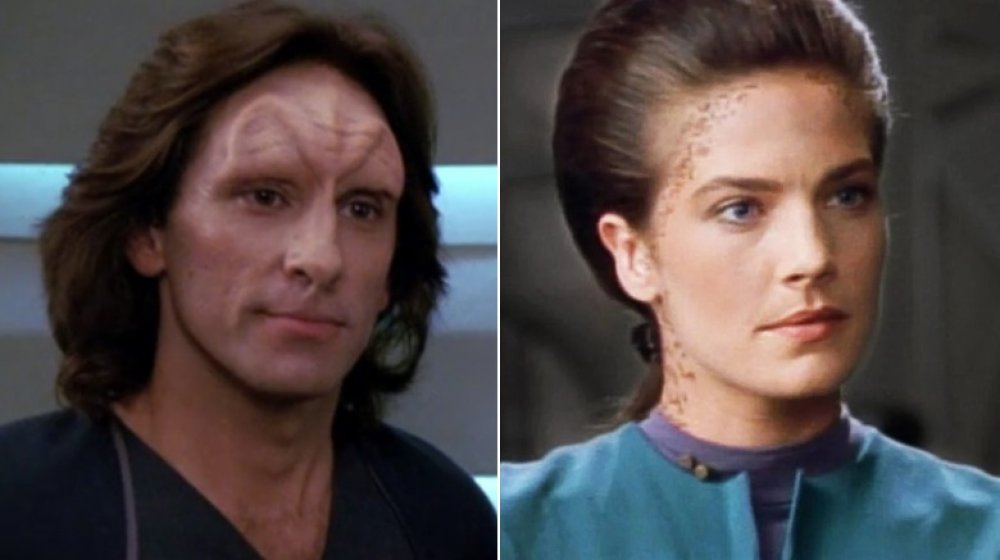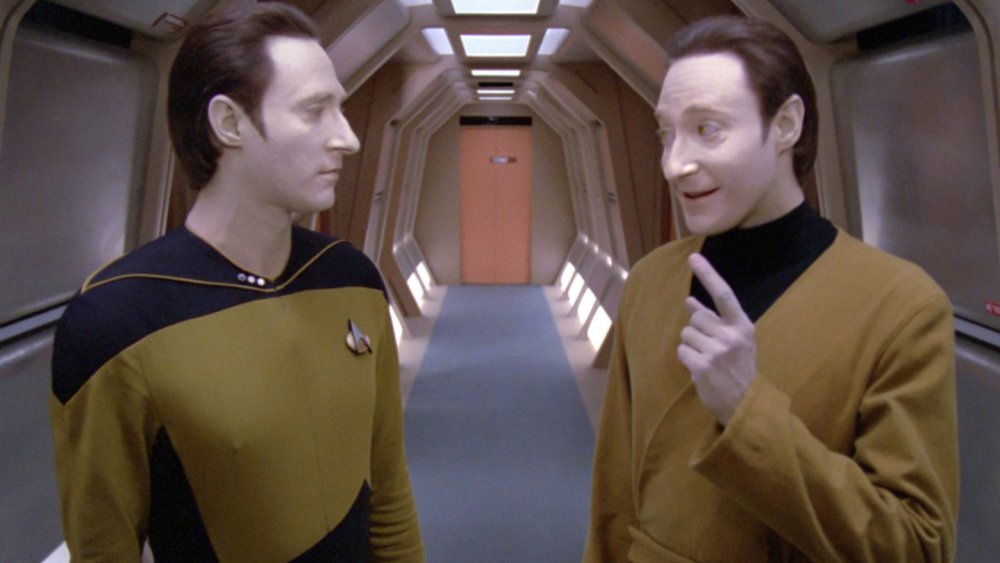The Biggest On-Screen Mistakes In Star Trek TV Shows
Making a television show is no small endeavor. Even a series with a relatively small budget has a lot of moving parts. There are the actors, of course, but then there's everything that goes on behind the camera. There's make-up, wardrobe, lighting, writing, camera work, scheduling, editing, and more. So every now and then, no matter how professional the creators are, something is going to fall through the cracks.
So naturally, the makers of Star Trek's growing list of TV series aren't immune to the occasional bungle. The Star Trek franchise has endured for half a century, and while its stories can be found on the movie screen and in other media, television is where you can find most of its tales. And while the makers of Trek work incredibly hard to get everything right — after all, Trek fans have earned quite the reputation for spotting mistakes in their favorite shows — the occasional slip-up makes it through to the finished product.
Whether they're editing blunders, wardrobe screw-ups, continuity errors, or other oversights, here are some of the biggest on-screen mistakes you'll find in Star Trek TV shows.
I'm a doctor, not a wardrobe expert!
One of Trek's earliest recurring antagonists shows up in the first season of Star Trek: The Original Series (TOS). In "Mudd's Women," the Enterprise beams aboard the irrepressible Harry Mudd (Roger C. Carmel) after his ship's engines overheat. His arrival is swiftly followed by that of a trio of women whose beauty leaves both Scotty (James Doohan) and McCoy (DeForest Kelley) dumbstruck, while Spock (Leonard Nimoy) seems curious about his Earthling colleagues' behavior.
Dr. McCoy's arousal isn't the only thing worth noticing about his appearance in this scene. When he first sees the women, McCoy is wearing his bridge uniform, which includes a light blue shirt with a dark blue collar. The camera cuts to one of Mudd's alluring ladies, and when the camera returns to McCoy, he's wearing the medical smock he usually reserves for sick bay duty. There are also windows behind him, meaning he's in a completely different part of the ship. The camera returns to Mudd's women, and the next time we see McCoy, he's back in the transporter room and wearing his bridge uniform.
Apparently whoever edited "Mudd's Women" didn't think McCoy looked aroused enough, so they used archived footage of him without caring about what he was wearing or where he was. Either that, or the space-time continuum was acting really weird that day.
Sisko's reappearing combadge is a pretty glaring Star Trek mistake
One of the more interesting season 1 episodes of Star Trek: Deep Space Nine (DS9) is "Dramatis Personae," when a contagion renders almost the entire crew power hungry and violent, except Odo (René Auberjonois). The crew is split into those backing Commander Sisko (Avery Brooks) and those loyal to the Bajoran first officer, Kira Nerys (Nana Visitor). After a botched assassination attempt on Sisko, the commander and Chief O'Brien (Colm Meaney) try to escape the station. One of the first things the two do is throw away their Starfleet communicator badges so that neither Kira nor anyone else can track them.
As the only member of the senior crew who isn't losing his mind, Odo manages to manipulate both warring parties into a cargo bay where he uses the cure he tricked Doctor Bashir (Alexander Siddig) into concocting. He then opens the cargo bay door to force the contagion into the void of space. Odo warns everyone to hold onto something before opening the door, and Sisko — still without a combadge — grabs onto a cargo container. We then get several shots of the different crew members fighting the pull into space. Once Odo closes the door, the camera goes to Sisko, whose combadge has inexplicably reappeared on his uniform.
You could try to explain this away by saying something like the combadge's return symbolizes Sisko's return to sanity, but otherwise, it's an obvious and very visible goof.
Geordi's uniform is stuck in yesterday's Enterprise
Look at just about any fan's list of the best Star Trek: The Next Generation (TNG) episodes, and you'll probably find "Yesterday's Enterprise." The story changes the Trek timeline, with Worf (Michael Dorn) no longer having a place on the Enterprise, Tasha Yar (Denise Crosby) being still alive, and the Federation in a losing war with the Klingons. Among other changes, the Enterprise's interior is a lot darker, and the crew's uniforms have changed.
The timeline is only able to find its way back to what we're used to because of the intervention of the enigmatic Guinan (Whoopi Goldberg), who senses something is wrong and convinces Captain Picard (Patrick Stewart) to make the difficult decisions necessary to put things back to the way they belong.
"Yesterday's Enterprise" ends with Guinan and Geordi (LeVar Burton) talking in Ten Forward. Guinan asks the chief engineer to tell her about Tasha Yar, someone she never meets in the original timeline. The goof is visible once Geordi comes into view. For some reason, Geordi is still in his uniform from the alternate timeline. We know this because of the black cuffs at the end of his sleeves, which aren't a feature of his uniform outside the altered timeline. Unless anyone chooses to use this for fuel for an expansive theory about Guinan never really succeeding in fixing the timeline, someone should've told Geordi he was in the wrong digs.
The case of the missing astrometrics lab
A lot of things change on Star Trek: Voyager after the introduction of the reformed Borg crew member Seven of Nine (Jeri Ryan). And unlike most of Voyager's regular cast, we don't often find Seven on the bridge, in the sick bay, or even in the kitchen with Neelix (Ethan Phillips). Instead, Seven spends most of her time in the astrometrics lab. It proves to be the perfect haven for Seven. It's one of the few places on the ship that gives her the chance to contribute significantly to the crew while for the most part staying apart from that same crew — a set-up she clearly prefers.
Unfortunately, the lab's prominence after Seven's arrival leads to a bit of narrative confusion. In season 7's "Shattered," when Chakotay (Robert Beltran) finds himself thrown back in time to an earlier version of Voyager, he tells Captain Janeway (Kate Mulgrew) that they need to get to astrometrics, and Janeway responds that Voyager doesn't have an astrometrics lab, implying it hasn't been built yet. But this isn't the case. While we never see the astrometrics lab before Seven comes on board, it's part of the ship even before Voyager is hurled into the Delta Quadrant. In season 4's "Revulsion," Chakotay orders Kim and Seven to update the lab, which he says hasn't been upgraded since before the events of the series premiere. How could it have been upgraded if it didn't exist?
The Velcro thief is a big historical mistake
One of the more interesting episodes of Star Trek: Enterprise is season 2's "Carbon Creek." It's unique because a huge chunk of it doesn't even feature the regular cast. Jolene Blalock does double duty as both the Vulcan first officer T'Pol and T'Pol's ancestor, T'Mir. T'Pol surprises Captain Archer (Scott Bakula) and Trip (Connor Trinneer) by claiming that long before Earth's first contact with Vulcans, a small group of the aliens — including T'Mir — crashed in the United States in the '50s and were forced to immerse themselves in the culture while keeping their origins secret.
While T'Mir is initially very critical of her colleague Mestral (J. Paul Boehmer) who seems to show more interest in humans than T'Mir would like, eventually, she falls victim to the same sympathy. Just as Scotty (James Doohan) sells the secret of transparent aluminum in 1986's Star Trek IV: The Voyage Home, in 1957, T'Mir takes a trip to Pittsburgh and sells the secret of what would become known as Velcro so she can get enough money to help a human boy pay for his college tuition.
The only problem with this detail is that not only did someone else invent Velcro, but it was patented in 1952, and it was already in use in the United States. Obviously, '50s grade schoolers weren't securing their sneakers with them yet, but it was still out there.
The resurrection of Joseph Sisko
The father/son relationship was an important recurring theme in DS9, usually manifesting with the love between Ben Sisko and his son, Jake (Cirroc Lofton). But in a season 4 two-parter, that relationship expands to include Ben's father, Joseph Sisko (Brock Peters). We meet the stubborn but charismatic restaurant owner when Ben is summoned to Earth to brief Starfleet on the growing threat of the Dominion. Joseph refuses to slow down no matter what his doctors tell him, and he's adamant that, come hell or high water, his son and grandson show up in time for dinner.
Of course, the only problem with the appearance of Joseph Sisko is that earlier in the series, we're led to believe he's dead. Ben Sisko never outright says he's dead, but all the statements he makes about his father before season 4 strongly imply he'd already passed on. For example, in both the series premiere and season 2's "Paradise," Ben refers to his father in the past tense. For example, he says, "My father was a gourmet chef." In season 2's "The Alternate," Ben tells Odo of an illness his father went through, strongly implying he died from it.
There's never any real explanation as to the discrepancy between Ben's early remarks and Joseph being alive and well. Regardless, Joseph is a beloved character who continued to appear in the series on a recurring basis after his first appearance in season 4, and we're glad he was around to see it through.
City on the edge of the wrong forever
Written by the acclaimed science fiction writer Harlan Ellison, "The City on the Edge of Forever" regularly shows up not only in lists of best episodes of TOS but favorite chapters of the Trek franchise as a whole. Plus, it's one of the saddest episodes of Star Trek you're likely to see. Regardless, there's a blink-and-you'll-miss-it boo boo in the episode that could take you out of the story pretty fast.
The story transports McCoy, Spock, and Captain Kirk (William Shatner) back in time to the Great Depression. Kirk and Spock masquerade as homeless men desperate for work as they search for McCoy, whose actions — they fear — have deeply harmed the timeline. The pair secure an apartment where Spock uses the relatively primitive technology of the time to figure out exactly what it is they need to prevent from happening.
It's that apartment that provides this episode with its goof — or, more accurately, the apartment building. After a scene in which a homeless man accidentally vaporizes himself with McCoy's phaser, the camera cuts to the exterior of Kirk and Spock's building. On the right side of the building, you can clearly see a sign with the universal symbol for radiation, alerting passersby that the structure includes a bomb shelter in case of nuclear attack. Such signs didn't exist until the 1960s, at which point the Great Depression had been over for decades.
Stop complaining, Worf
Season 4 of DS9 brings an old friend back to Trek TV. In the season 4 premiere "The Way of the Warrior," the Klingon Worf is sent to the space station on special assignment, and by the end of the episode, Worf is a member of Captain Sisko's senior staff. Along the way, the son of Mogh makes at least one statement that doesn't hold up to scrutiny.
Worf is sent to DS9 to investigate the Klingons, who are preparing to invade the nearby Cardassian Empire. Soon after the Defiant leaves DS9 on a mission to save the Cardassian leadership from the Klingons, Sisko orders the ship's cloaking device — on loan from the Romulans — to be activated. Worf seems a bit uneasy, and when Sisko asks him about his demeanor, the Klingon responds that he's never been aboard a Federation ship with a cloaking device and that it's "a little strange."
The thing is, it actually isn't the first time Worf's been aboard a Federation ship with a cloaking device. Toward the end of the TNG season 7 episode "The Pegasus," the Enterprise uses a prototype for a Federation cloaking device, and Worf is on the bridge when it happens. You could argue the Enterprise is only cloaked very briefly in "The Pegasus" so it's understandable he forgot about it, but Worf is a pretty detailed guy. He doesn't forget his Klingon operas, and he wouldn't forget being cloaked on the Enterprise.
The Trill are Star Trek's most confusing aliens
In TNG's "The Host," the Trill diplomat Odan is badly injured, and the Enterprise crew discovers there is a slug-like creature living inside him with whom he shares a symbiotic relationship. This concept was also used in DS9 with Jadzia Dax (Terry Farrell) and later Ezri Dax (Nicole de Boer).
However, there are huge discrepancies between what we learn about the Trill in "The Host" and what we see in DS9. In "The Host," Odan (Franc Luz) has prominent forehead ridges, a feature we never see on another Trill. Both Odan and Dr. Crusher (Gates McFadden) say that using transporters are dangerous to symbionts, but Jadzia and Ezri use transporters without issues. In "The Host," the symbiont's presence is a complete surprise to the Enterprise crew. But in DS9, we learn Trill have been a part of the Federation for a long time, and the existence of the symbionts is common knowledge. For example, the Dax life-form's earlier host, Curzon, was the Federation's ambassador to the Klingon Empire for years, and he's friends with Klingons old enough to have fought Captain Kirk.
Finally, there's the relationship between host and symbiont. In DS9, it's made clear that the personality of what's called a "joined" Trill is a mixing between the personalities of the host and the symbiont, while in "The Host," it's made to appear only the symbiont's personality exists. Odan claims to be the same person both when he inhabits the body of Riker (Jonathan Frakes) and when he later appears in a woman's body.
Star Trek made a huge mistake with Data's contractions
One of the best recurring bad guys on TNG is Data's (Brent Spiner) evil twin, Lore, who has almost all of Data's abilities, coupled with twisted emotions and a total lack of empathy for other living beings. We first meet him in season 1's "Datalore," when he deactivates Data and tries to pass himself off as his more noble brother. The first member of the crew to realize something is wrong is Wesley Crusher (Wil Wheaton), who notices that Lore — while disguised as Data — uses contractions (e.g. "can't" instead of "cannot" or "I'm" instead of "I am"). This is strange to Wesley because Data never uses contractions.
The only problem is that Data totally uses contractions. Clearly, the "no contraction" rule isn't established before "Datalore." In the season premiere, Data jokes about Q (John de Lancie), saying, "At least we're acquainted with the judge." Earlier in the same episode, questioned by the elderly McCoy about his strange demeanor, Data says, "I'm an android." In fact, the rule doesn't seem to be set in stone even after the contraction rule is established in "Datalore" as he tells Picard, "I'm fine," at the end of the episode and continues to occasionally use contractions in subsequent episodes.
In the end, it all works out, and Lore's schemes are foiled. The real lesson here is that you shouldn't try to take your brother's place, otherwise Wesley Crusher will make up lies to expose you.
